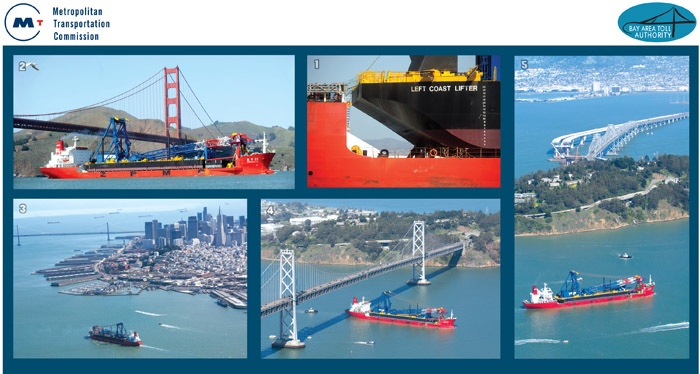An immense, barge-mounted crane dubbed the "Left Coast Lifter" that will be used to help build the San Francisco-Oakland Bay Bridge’s new suspension span passed under the Golden Gate and into San Francisco Bay on Thursday, March 12.

The “Left Coast Lifter” crane and barge slipped under the Golden Gate, skirted the San Francisco shoreline and passed under the West Span of the Bay Bridge; the final destination is the Bay Bridge East Span construction zone on far side of Yerba Buena Island (visible in image 5). Photos 1 and 2 are by Noah Berger and the aerial photos 3, 4 and 5 are © 2009 Barrie Rokeach.
“Left Coast Lifter” Sails Into San Francisco Bay
By Karin Betts
Published: April, 2009
An immense, barge-mounted crane dubbed the Left Coast Lifter that will be used to help build the San Francisco-Oakland Bay Bridge’s new suspension span passed under the Golden Gate and into San Francisco Bay on Thursday, March 12. The 400-foot-long barge – built by U.S. Barge in Portland, Oregon – was initially shipped to China a year ago for fitting by Shanghai Zhenhua Port Machinery Co. Ltd. (ZPMC) with a custom-built shear-leg crane capable of lifting up to 1,873 tons.
The replacement of the East Span of the San Francisco-Oakland Bay Bridge is one of the largest public works projects in California history, and requires the use of some of the biggest construction equipment that exists. And the Left Coast Lifter is no exception, weighing in at a whopping 3,920 tons. The extended boom of the shear leg crane is 328 feet long, and will tower above both the cantilever bridge and the new Skyway decks when raised.
This crane is the workhorse that will erect the remaining pieces of the new East Span, said Andrew Fremier, deputy executive director of the Bay Area Toll Authority (BATA), which is run by the Metropolitan Transportation Commission (MTC). It was built specifically for this project, and we’re glad to see it take its place in Bay Area history.
The Left Coast Lifter will be used starting this summer to offload and erect the steel used in the temporary support structures for the new signature span, as well as to raise all 28 deck segments of the new span’s roadway and the lower sections of its steel tower. The upper parts of the 525-foot tower are beyond the reach of the crane’s boom, so a strand jack system built into the tower’s temporary frame will lift those pieces into place.
During its month-long journey back across the Pacific, the self-erecting crane was stowed flat for transport, and the entire crane barge placed on a special semi-submersible ship. Within a week of its arrival at a mooring site south of the Bay Bridge, the crane barge was floated off the partially submerged ship and towed to a pier in the Port of Oakland, where it is being prepared for service. Later this spring, the fully operational crane will sit north of the new East Span construction site near Yerba Buena Island, in view of motorists driving over the Bay Bridge.
We’re at the point where the photographs being taken will end up in history books, said Bart Ney, Caltrans spokesperson. Over the next two years, with the help of this crane, we’re going to be erecting a self-anchored suspension span that is the largest of its type in the world.
The new East Span is two bridges in one: a sleek Skyway (with side-by-side roadways) that is already complete, and a self-anchored suspension span, or SAS, closing the gap between the end of the Skyway and Yerba Buena Island. The East Span project is being directed by the Toll Bridge Program Oversight Committee, a consortium of three agencies: MTC’s BATA, Caltrans and the California Transportation Commission. BATA is financing the $5.7 billion East Span project with bridge toll funding. For more information about the project, go to baybridge360.org and baybridgeinfo.org.

